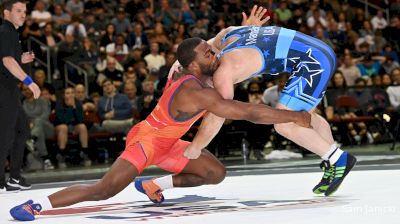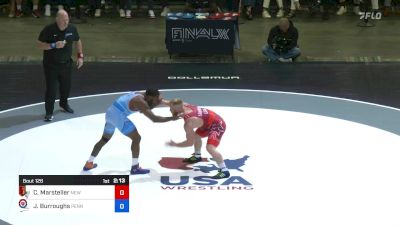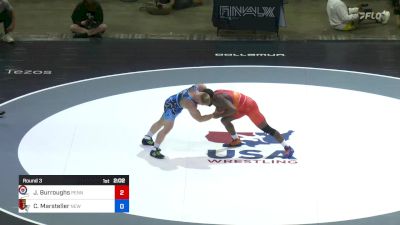UWW Rules Interpreter Weighs In On Series Defining 79 kg Sequences
UWW Rules Interpreter Weighs In On Series Defining 79 kg Sequences
Casey Goessl, the rules interpreter for United World Wrestling, explains the controversial Jordan Burroughs-Chance Marsteller three-match Final X series.

Chance Marsteller defeated Jordan Burroughs during a controversial three-match series at Final X for the 79-kilogram World team spot. Burroughs won the first match 3-3 and Marsteller won the subsequent two matches, 5-4 and 8-3.
Marsteller was ahead 3-2 late in the first match but Burroughs was given one point when Marsteller grabbed the singlet. Burroughs and Marsteller were in a four-point exchange at the edge of the mat during the third match that ultimately decided the outcome of the series.
Below is a question and answer with United World Wrestling (UWW) rules interpreter Casey Goessl about challenge procedures, fouls, and the debatable four-point move during match three.
Are there different rule sets for USA Wrestling and United World Wrestling?
Only in terms of the challenge procedure. Everything else is by the UWW book. Let me give you some background. If you remember, there was a situation that came up with Zain Retherford and Yianni Diakomihalis that went through arbitration after 2019 Final X. Ultimately, we wrestled one match during a special wrestle-off in Pennsylvania to decide the World Team member (at 65 kg) that year.
The problem with the UWW challenge rules at that time was the written rules and how those rules were applied at international events were not the same. The old rules dictated that a challenge must be offered five seconds (now 10 seconds as of 2023) after the score was posted on the scoreboard. Anyone that has watched high-level international wrestling knew that this time constraint was not enforced. The intent of the rule is sound: a challenge must be offered in a timely fashion, but the time constraint was never black and white.
Based on the decision in the aforementioned arbitration and to avoid a similar situation in future events, USA Wrestling and us as referee leaders decided to clarify the challenge procedures and what would be an acceptable challenge.
For example, after a natural stoppage in a match, if a challenge is not offered prior to the restart, we will not accept the challenge for anything prior to that stoppage. We just wanted to put some rules into our challenge procedures that better matched the overall application of the rule internationally, hence the reason a challenge must be offered in a “reasonable amount of time.” We had those in place and they were approved by USA Wrestling and the various sports committees by late 2019, early 2020. Coaches present for the 2021 Olympic Trials seeding meeting were informed of the challenge rules that would be enforced and continue to be enforced to this day.
Going into the 2020 Olympic Trials — of course, that was delayed a year to 2021 — we had those challenge-specific rules for USA Wrestling that are the same challenge rules we use with all of our age groups since early 2020. These rules were amended slightly this year to account for a change in the UWW challenge rules where a challenge is considered “won” if any change to the score is made from the original call whether it benefits or does not benefit the challenging wrestler.
Just to clarify, the rules and how they are interpreted at a UWW level and a USA Wrestling level are exactly the same?
Yes. Going into 2022, USA Wrestling removed any modifications we had in place for the various age groups and adopted all UWW rules as our rules set. The only difference we make is one exception for uniform requirements based on religious affiliation that is only valid in domestic, non-UWW qualifying events, but is disallowed internationally.
Keep in mind that UWW rules are only in effect from U15 on up. There are some things we have to take into account with younger wrestlers when evaluating scoring maneuvers and the safety of some actions that might differ from UWW since we are dealing with younger age categories that aren’t considered in the UWW rules set. In terms of senior athletes, minus the challenge modifications that we’ve had in place for several years now, we abide by UWW rules.
Why was Jordan Burroughs awarded a point when Chance Marsteller grabbed the singlet during the first match?
You’re looking at a sequence at the end of the match where clearly one wrestler is protecting the lead and one wrestler is trying to score. You have an offensive and defensive athlete. During the challenge, when we observed the singlet pull from a defensive athlete, at that point it was a direct foul. It is impossible for us to determine what effect the singlet foul may have had on Jordan’s rhythm and ability to score. In fact, when you see the foul, it looks like Jordan is trying to cut the corner to score a go behind.
We give the offensive wrestler an initial warning if we determined that the offensive wrestler grabs the singlet for that infraction. The next time it would be a penalty. In this circumstance, we felt Chance was in a defensive position. He grabbed the singlet and, per UWW rules, that’s a penalty.
For anyone that might argue that the challenge was not offered in a reasonable amount of time, I would say that it would be really difficult for us to ask a wrestler scrambling to score points at the end of a match to stop what they are doing and request a challenge, especially if they are in a position that favors his or her style. Since none of the referees observed the foul in real time and were unable to stop the match to assess the penalty, we as jury members were forced to make that decision during the review.
What are you calling that situation?
The term we use internationally is just a foul for unsporting behavior. A defensive foul.
So Burroughs got one point for a defensive foul?
It’s a caution for Chance in that situation and one point for Jordan.
How long do you have to challenge the call?
Our USA Wrestling challenge rules indicate a reasonable amount of time. I understand that that’s arguable but we felt that it was very much a dynamic wrestling situation at the end that everything in that sequence needed to be reviewed. We felt in that situation that Jordan was obliged to have a challenge and he was afforded that right. In our eyes, we felt like we didn’t have any other choice than to assess the penalty.
Why was Pat Smith grabbing headgear during his Greco match only an attention?
In that situation, we didn’t feel like either wrestler was in a clearly defensive posture. We felt that it was a grab to gain position. We didn’t think any wrestler was clearly in an advantage position at that point where grabbing the headgear would be a foul worthy of a penalty at that point.
Walk us through the four-point move at the edge of the mat during match three and how you interpreted that.
I want the general public to understand that the views that they may see that are posted online aren’t necessarily seen during a review. We share some resources in terms of camera angles but we don’t necessarily get that specific view that you may see in other places.
In the views we had available to us, there are clear actions going out of bounds. Jordan clearly initiates a leg attack. As they are going out of bounds — to us — it felt like there was a slight pause in Jordan’s attack. At that point, as they are falling into the protection area, there’s no clear step out from Chance. Jordan lets go of his lock, you see just a slight turn from Chance and he doesn’t land flat. Chance turns as Jordan lets go of his lock. At that point, Jordan goes into a danger position.
It’s either four for Jordan or it’s four for Chance.
We saw a stoppage in that line of drive. You see Chance turn, there’s a slight change of direction in the overall action, and we felt the best call in that situation was four points for Chance.
Will you explain continuation and what that means going out of bounds?
Generally, if the action starts inbounds, we’ll allow continuation to a point. We have to draw the line in the sand somewhere. You can’t land in the next mat over and think we’re going to score that. If a wrestler starts an action in the central wrestling area and they go out of bounds, they’re allowed to finish that attack. If they step out with one foot and finish, we’ll score that action. The minute they step out with two feet, we won’t score that action since it’s out of bounds at that point.
I understand from a fan’s point of view that what we do is very difficult to understand at times. It’s like arguing politics. Nobody is going to win. However, there are some objective measures that we use to assess some of those difficult situations.
We felt in many ways that it was like a multiple-choice test. You have to choose the best answer. In that last situation with Burroughs and Chance, that’s the approach we took. We felt that four points for Chance was the best answer and the best scoring option in that circumstance.
I don’t expect to make any friends with the decisions we make. However, I do hope that wrestling fans respect the transparency we are trying to provide in our decision-making and do what’s in the best interest of the athletes in a fair, honest fashion.
Below are all three matches of the best-of-three series in sequence between Jordan Burroughs and Chance Marsteller.


